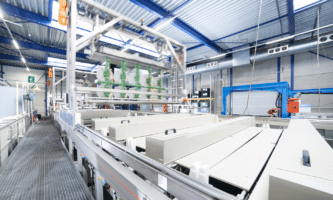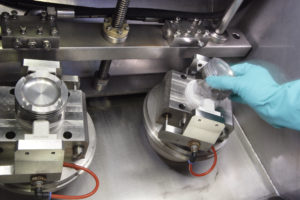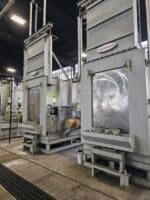alternative to the chromium(VI)-containing electrolyte for SELGA-COAT®
Until now, the use of an electrolyte containing chromium(VI) was unavoidable in SELGA-COAT® technology to produce special coating properties. This electrolyte is characterized, for example, by the production of particularly smooth coatings even on aluminum casting materials with a high silicon content. Due to the high toxicity of chromium(VI) oxide, the development of an alternative to the chromium(VI)-containing electrolyte has been the focus of research work for some time.
The new chromium(VI)-free electrolyte in combination with SELGA-COAT® technology produces anodic coatings that can meet the technical requirements, such as coating thickness, hardness or roughness, to the same extent. The development thus secures the use of the process and contributes to sustainable and efficient anodizing.
SELGA-COAT® process
SELGA-COAT® is a technology for the selective electroplating of workpieces. In contrast to dip anodizing, only defined surface areas are selectively refined in selective anodizing. A delimited area of the component surface is flowed around by a rapidly circulating electrolyte, and accordingly only this delimited surface is anodized.
Often, a complete coating of the component is not necessary at all, but only certain surfaces on a component are to be functionally refined. In this case, it can happen that each partial surface to be coated has different coating properties.
Another advantage of selective anodization is the short coating time, which can be less than 60 seconds for a layer thickness of 10 to 20 μm. If only those surface areas are anodized that also require it from a stress point of view, there are also energy savings and thus fewer CO2 emissions.
development of the chromium(VI)-free electrolyte
The classic SELGA-COAT® electrolyte is characterized by the production of hard anodic coatings with lowest roughness even on high-silicon aluminum casting alloys. However, it contains chromium(VI) oxide, so it was necessary to develop a chromium(VI)-free solution that would continue to meet customer requirements by providing at least the same coating properties.
After investigating a variety of acids and additives, a solution was found: The new electrolyte is based on sulfuric acid with additions of molybdenum and tin compounds. It meets existing customer requirements, and the coating properties are comparable to those of the chromium(VI)-containing variant. Due to the material dependence of the anodic coatings, validation must be carried out for new components and possibly additional coating requirements such as corrosion protection by means of suitable sampling to be able to evaluate individual material and component influences.




